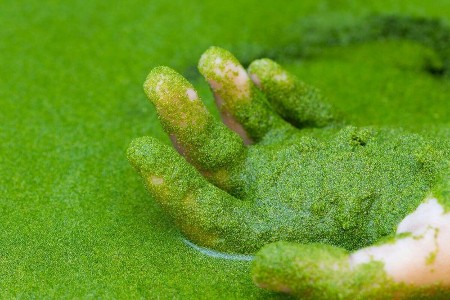A much younger version of me once had a collection of aquariums in my parents’ home where I was breeding many different species of fish. I even had a pet crayfish that moulted every year. The varnished exoskeletons were prominently displayed on a bookshelf in my parent’s den. One thing I had no trouble growing was duckweed. The surfaces in my tanks were covered with it and I was constantly scooping it out of the way to give me a clear path to feed my fish. Duckweed was a great oxygenator supplementing the filters and air pumps I used to keep the tank water healthy.
I can attest to one of its properties. It replicates every 24 hours doubling in amount. So could it become a food source for humans? I know my turtles loved it but could we acquire a taste for this plant?
Duckweed, which goes by two different Latin names, Wolffia, and Lemna minor. It apparently tastes like spinach and can be found in Southeast Asian cuisine where it is called Khai-nam, translating into English as water eggs.
The plant which appears as a flat oval leaf, no more than 0.6 centimetres (0.25 inches) in size, floats on water surfaces. It largely reproduces asexually, although I remember seeing it flower upon occasion in my tanks. When it flowers outdoors small insects or water movement creates pollination opportunities. But the vast majority of new duckweed comes about asexually. How fast? I used to turn my tank lights off at night only to find in the morning an entirely new crop of tiny plants floating on the surface. A 75-litre (20-gallon) tank could see the water surface covered in a week. The amount that grew was often thick enough to support the weight of my resident salamanders. frogs, and turtles.
It is its reproductive capacity that has attracted interest from scientists at the Salk Institute for Biological Studies in La Jolla, California, who have been studying the plant’s genome to determine what makes that aspect of it tick. Scientists have isolated the genes responsible for the plant’s reaction to day/night cycles a key stimulus for most plant growth. Surprisingly the plant has only half the number of regulatory light and darkness cycle genes found in most plants. The La Jolla researchers speculate that the absence of genes may be the reason the plant replicates so rapidly in an almost uncontrolled fashion.
This rapid growth in the wild has often been seen as a nuisance because duckweed can physically cover a small water surface in record time. But that fast growth has many uses for an increasingly challenged world dealing with climate change and food insecurity.
Today, other than Khai-nam on Southeast Asian plates, duckweed, where harvested, is used as a livestock feed supplement. It also is proving to be good at remediating contaminated water sources where nitrogen and phosphorous runoff from farms is polluting rivers, ponds, and lakes. Tinkering with the genome is giving biomedical companies the opportunity to use new versions of the plant to produce medicines including insulin.
Back in my youth when I was scooping up these tiny plants from my many aquariums regularly, who knew of their enormous potential.
















